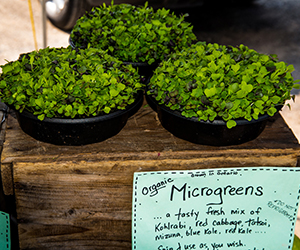
Microgreens are one of the latest trends in food and nutrition these days. The health conscious are piling these plants on their sandwiches, mixing them with their salad, and sneaking them into smoothies.
What are microgreens?
As the name implies, these are small green plants. More specifically, they are the seedlings of edible vegetables and herbs. Just to be confusing, microgreens and sprouts are not the same. Sprouts are usually grown in water and harvested within 2-3 days. Microgreens are grown in soil, exposed to sunlight, and allowed to grow for 1-3 weeks, until they reach about 2 inches tall. If allowed to grow for longer (until about 3-4 inches) they are called baby greens.
Microgreens vary in taste according to which vegetable they come from, ranging from mild, to spicy, tangy, or even peppery. They can taste different from their adult version, can come in a rainbow of colors, and can have a satisfyingly crisp texture even if their full grown version does not. They can be from any herb or vegetable, but most frequently you’ll find microgreens from:
- Cilantro
- Arugula
- Radish
- Basil
- Amaranth
- Beets
- Broccoli
- Kale
Available research is rather limited on the nutritional qualities of microgreens, but they do appear to be low in calories yet high in vitamins, minerals, antioxidants, and enzymes which is ideal for health conscious eaters, including gastric sleeve, gastric bypass, and lap band patients.
Are they good for you?
Consuming plant based foods (including microgreens) has many benefits: reduced risk of obesity, diabetes, high blood pressure, cancer, and heart disease. Each type of microgreen will have a different nutrition profile, and not enough research has been done to adequately quantify it, but on the whole it is easy to say that consuming microgreens is a good food decision. For gastric sleeve, gastric bypass, and lap band patients, eating foods that offer quality vitamins and minerals with a small number of calories is crucial for weight loss and good health.
How do you eat microgreens?
You can use microgreens just like you would use lettuce: in a salad, on top of tacos, inside a sandwich or wrap. But, you can also add them to smoothies, soups, omelets or frittatas, enjoy them as a garnish, or any other way that works for you.
The above Food Highlight is offered by Dr. Shillingford, M.D., P.A., a board certified surgeon specializing in advanced laparoscopic and bariatric surgery. Dr. Shillingford’s gastric sleeve, lap band, and gastric bypass patients come to his Boca Raton office from both South Florida and Northern Florida, as well as Georgia, Texas, Ohio, New York, New Jersey, and Michigan. His weight loss surgery patients are often looking to explore new and different foods, and microgreens are both new and different. What’s more is that because they are harvested so quickly, they are easy to grow at home, even if you don’t have a green thumb.

 Am I A Candidate
Am I A Candidate  BMI Calculator
BMI Calculator  Why Choose Us
Why Choose Us